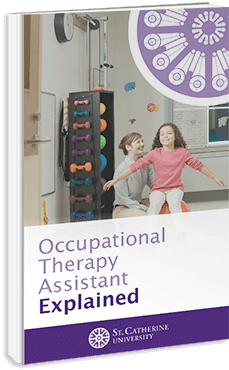My Most Memorable Part of Occupational Therapy School
Each blog post is dated and contains accurate information as of that date. Certain information may have changed since the blog post publication date. If you would like to confirm the current accuracy of blog information, please visit our Online OTA program overview page or contact us at (877) 223-2677.

This week, our guest blogger shares one of her most memorable experiences in her OT training program.
When I started my occupational therapy program, I was so excited to be learning stuff I was interested in and would be able to apply to my future career. This was a change from college, where I had taken some classes that were interesting but would not have been applicable to my aspirations to become an occupational therapist, including Entomology 101: Insects, Friend or Foe; and Exercise to Music, to name a couple. During my OT program, I immersed myself in my coursework, going above and beyond anything my professors requested. I thought I knew everything, that I was ready to get out and start fieldwork and be the best OT there was. Not just the best OT student, but the best occupational therapist, period.
The idea of fieldwork excited me. I was going to put the hours I had spent studying to work, treating whatever client may come my way. Nothing could compare to what you experience during your fieldwork. And then came the awakening.....fieldwork.
A definition of fieldwork: A humbling experience where you are reminded that you don't know everything.
Fieldwork turned out to be one of my most memorable parts of OT school. My occupational therapy school gave me the opportunity to experience four different OT settings, including an inpatient rehab facility (primarily neuro), outpatient pediatrics, skilled nursing and acute psychiatric settings.
Of those four, my favorite was inpatient rehabilitation. Inpatient rehab is where I found my love for brain injury treatment (stroke and traumatic brain injury). It fascinated me how much someone's life could change so quickly. There was one patient I had treated, Samantha*, who really stood out to me. Samantha was my first TBI experience, and I don't think I could ever forget her.
Samantha had her accident at work, where she worked in a warehouse and had fallen off a forklift and sustained a TBI. This accident left Samantha wheelchair bound, incontinent, with decreased functional use of her arms and with dysarthric speech, just to name a few of the deficits. Prior to her accident, Samantha was very social. Her husband was in a band and she went to his shows, she loved crafts and music and was described as a busy bee; she never stopped moving and was always helping whomever she cross paths with. When working with Samantha, I would sometimes get a glimpse of who Samantha was prior to her accident, which was nice to see. However, most of the time in therapy you realized how much she was struggling to adjust to this new life that was forced upon her. And then my fieldwork education showed me what being at OT was all about. In our OT training, we were constantly told how important it is for treatments to be occupation based. My educator was very skilled at being an occupational-based interventionist. She appeared effortless at each treatment session when she would have Samantha complete an occupation-based task. Some of these memorable occupation-based treatments included:
1. Target trip: One day Samantha was really down. She felt she couldn't be sexy anymore. Prior to her accident, Sam had style. She liked wearing heals, dark jeans, form fitting tops and was known for her funky accessories. So one day we went to Target to help her pick out clothes that were congruent with her pre-accident self.
We didn't realize how emotional this trip would be until we got to Target. As soon as Samantha entered the store she became tearful. This was one of Samantha's first times out in the community in a power wheelchair since her accident. She felt like people were staring at her and moving out of her way because she was different. We felt awful for her, having not anticipated Samantha getting so emotional. However, after a long talk she gradually became more comfortable and we were able too find her a "sexy" outfit. The next day, during her morning ADL, she changed into her new outfit. Samantha was on fire during therapy that day. Though she wasn't completely better, she finally felt a little more like her previous self.
2. Activity Card Sort- I had learned about Carolyn Baum's activity card sort. However, I had never seen it used the way my fieldwork educator did. Instead of using the activity card sort in the traditional way of sorting the cards into piles of what activities someone was doing now, did in the past and would like to do now, we used it as a tool to help Samantha identify what she was still able to do since her accident. The first time through, Samantha had almost all the cards in the "can't do" pile. She went through the pile again and we helped her identify adaptive ways to do the activities and her "can do" pile began to grow. Samantha felt empowered and appeared to be more motivated to not let he accident slow her down.
3. Wreath making: One thing Sam identified as an activity she wanted to get back into was wreath making. Her husband brought in some of her supplies and we quickly got to work. We used a green foam mold and made holes into so it resembled a pegboard. We then had Samantha use her hands to insert a wire flower into the holes. Samantha use her hands more that day they she had done in previous sessions. She was motivated to complete her wreath. It is a great example of occupation-based therapy.
You will have countless memorable experiences and patients as an occupational therapy. Some may make you laugh so hard you cry, some may concern you to a point where you can't sleep and most will touch your life in one way or another. We can be grateful that we are in a profession that gives us so many memorable experiences.
*name has been changed to protect patient privacy
Are you excited to start your occupational therapy assistant training so you can work in a remarkable field? Take a look at the online OTA program offered through St. Catherine University to learn how you can be an OTA in as little as 16 months.


